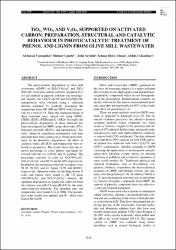TiO2, WO3, AND V2O5, SUPPORTED ON ACTIVATED CARBON: PREPARATION, STRUCTURAL AND CATALYTIC BEHAVIOUR IN PHOTOCATALYTIC TREATMENT OF PHENOL AND LIGNIN FROM OLIVE MILL WASTEWATER

Göster/
Tarih
2017Yazar
Vaizoğullar, Ali İmranUğurlu, Mehmet
Ayyıldız, Aylin
Yılmaz, Selman İlteriş
Chaudhary, Abdul J.
Üst veri
Tüm öğe kaydını gösterÖzet
The photocatalytic degradation of olive mill wastewater (OMW) of TiO2/V2O5/AC and TiO2/ WO3/AC (activated carbon) catalysts, prepared by a sol gel method in aqueous solution was investigated. Initially, the TiO2/V2O5/AC and TiO2/WO3/AC nanoparticles were obtained using a sufficient thermal treatment by gradually increasing the temperature from 300, 400 and 500 degrees C with 1 h intervals for a total of 3 h. Then, the characterizations of these materials were carried out using (SEM), (TEM), (EDX), (FTIR) and X- (XRD). Secondly; the photocatalytic degradation of these materials has been investigated in OMW using ultraviolet (UV), hydrogen peroxide (H2O2) and nanoparticles. Initially, chemical coagulation experiments with lime and alum have been carried out to obtain more treatment. In the photolytic degradation, the effect of catalysis, times, pH, H2O2 and temperature were selected as parameters. The results show that the removal percentage of color, phenol and lignin increased with the use of H2O2 and O-3 together. The percentage removals of color for TiO2/WO3/AC, TiO2/V2O5/AC were 89.55 and 86.30% respectively. In addition, the percentage removals for phenol were 94.30, 96.26% and for lignin 51.96 and 48.08%, respectively. Optimum values for the degradation of color and phenol were found at pH 7.0 using TiO2/WO3/AC, and TiO2/V2O5/AC, whereas, the optimum degradation for lignin was achieved when the solution was pH<5.0 and pH>9.0 for the same nanocomposite materials. The optimum time and temperature were found 24 h at 308K. The pseudo first order model was applied and R-2 values were from 0.90 to 0.99.

















